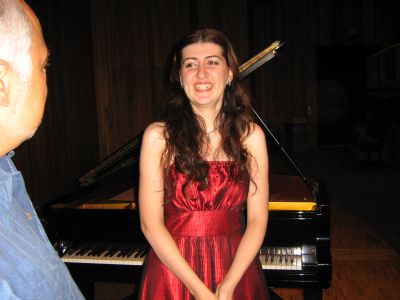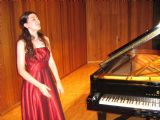|
Chamber
FAMILIAR AND NEW - TRIO NAVARRO'S SPRING CONCERT IN WEILLby Terry McNeill Sunday, April 21, 2024 Symphony
MONUMENTAL MAHLER 5TH IN SO CO PHIL'S SEASON ENDING CONCERTby Terry McNeill Sunday, April 14, 2024 Chamber
OAKMONT SEASON CLOSES WITH STRAUSS' PASSIONATE SONATAby Terry McNeill Thursday, April 11, 2024 Chamber
MORE GOLD THAN KORN AT ALEXANDER SQ CONCERTby Terry McNeill Sunday, April 7, 2024 Choral and Vocal
VIBRANT GOOD FRIDAY REQUIEM AT CHURCH OF THE ROSESby Pamela Hicks Gailey Friday, March 29, 2024 by Peter Lert Saturday, March 23, 2024 Chamber
NOT A SEVENTH BUT A FIRST AT SPRING LAKE VILLAGE CONCERTby Terry McNeill Wednesday, March 20, 2024 by Terry McNeill Saturday, March 16, 2024 Choral and Vocal
A ST. JOHN PASSION FOR THE AGESby Abby Wasserman Friday, March 8, 2024 Choral and Vocal
SPLENDID SCHUBERT SONGS IN SANET ALLEN RECITALby Terry McNeill Saturday, March 2, 2024 |
HIGH ARTISTRY IN CONCERTS GRAND'S OPENING RECITALby Terry McNeillSunday, September 20, 2009
Anticipation was in the warm air Sept. 20 in Santa Rosa’s Newman Auditorium. In addition to being the first Concerts Grand Series recital of the year, there was excitement surrounding the Armenian pianist Nareh Arghamanyan, making her Northern California debut amid extravagant press notices and comparisons with such artists as the young Alicia de Larrocha.
Following intermission the pianist returned to perform the recently-popular Pletnev transcription of seven scenes from the Tchaikovsky “Nutcracker” ballet. With themes so familiar, Ms. Arghamanyan was free to lavish her considerable command of color and texture, each part unfolding differently than the preceding. The Intermezzo was especially effective, depicting the cold Russian winter, as were the strains of the celesta and harp in the Dance of the Sugar Plum Fairy. I found the playing ravishing, and deft pedal use allowed the artist to generate piano sound (as opposed to architecture or color) in and for itself. That is not a common trait in youthful pianists. The recital ended with a signature piece for the artist and the work which captured the audience in her gold medal success at the 2008 Montreal International Piano Competition, the second Rachmaninoff Sonata. Ms. Arghamanyan used the composer’s revised version (1931) and gave a volcanic performance, but perhaps without the last bit of sonic power. Newman has dead acoustics but is sufficiently small that even a slightly underplayed Rachmaninoff work has considerable impact. It’s a three-movement work but the pianist gave the impression of having only one, the drama of the opening and closing Allegro sections connected by a lyrical and pensive interlude. Here again Ms. Arghamanyan’s mastery was evident, making a super-romantic composition cohesive and telling. No one was left in their seats following the final forte crashes, and one wondered what the demanded encore could be after the sonic carnage of Rachmaninoff’s glorious finale. It was a wise encore choice, the nostalgic Bach arrangement of his contemporary Alessandro Marcello’s Adagio from the Oboe Concerto in D, BWV 974. Here Ms. Arghamanyan lavished lovely pianistic colors, paired with virtually no tempo fluctuation and a staccato touch. It was a riveting reading. The recital stands with the recent Santa Rosa piano concerts of Hamelin, Kuschnerova, Pompa-Baldi and Nakamatsu as radiant musical art. And Ms. Arghamanyan is just 20. The reviewer is the Producer of Concerts Grand. Jim Burns and James Houle contributed to the review. Marin pianist Kenn Gartner attended Ms. Arghamanyan's recital and submitted comments on the pianism: I shall not discuss interpretation (one may surmise what the mature Nareh Arghamanyan will do) or repertoire; instead, I shall confine my remarks to the reasons why this performance was so successful. What was it about this young pianist's playing that entranced the Newman audience? For example, her two-note phrases were done beautifully. This is set of two notes, the first of which is louder than the second, and the second note starts at the level of the first note's decay. The pianist also took time to breathe. Most phrases in music are composed according to how long a human may sing them. Thus, there was time for breath between each sentence (a term also utilized in music) which varied according to the interpretation of the music. There were frames of silence around the movements and the works, and she kept her hands on the keyboard and thus conveyed to the house she was not finished with the work. Her fortissimi were, for the most part, non-percussive: when she played loudly (and this piano was not truly able to respond to her demands) we did not hear the fingers rapping the key, a failing in many pianists. Instead, she grabbed the keys, thus avoiding the additional rap of the key hitting the key-bed. Miss Arghamanyan's pianissimos were made the same way: she pulled the sound from the instrument and controlled the descent of the key. Last, and certainly not least, this pianist took the time to construct her phrases. If a particular moment required more time (this is the concept of the agogic) she took that time, stretching the music where it needed to be stretched, contracting the music where it needed to be contracted for the purpose of her vision. Think of what Chopin terms tempo rubato, or “stolen time.” The playing here had rubati, but the stretching of pianistic lines to create drama and sentiment goes far beyond what Chopin mentions. My personal comment to her as she departed was that “This recital was worth 40 piano lessons!" She was so modest and unassuming I needed to explain that chronological age should never be an issue. I learned a lot. |
|
Copyright © 2024 Classical Sonoma | Questions, comments, corrections: info@classicalsonoma.org


